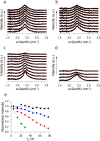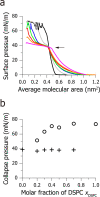Low-flux scanning electron diffraction reveals substructures inside the ordered membrane domain
- PMID: 33349660
- PMCID: PMC7752913
- DOI: 10.1038/s41598-020-79083-7
Low-flux scanning electron diffraction reveals substructures inside the ordered membrane domain
Abstract
Ordered/disordered phase separation occurring in bio-membranes has piqued researchers' interest because these ordered domains, called lipid rafts, regulate important biological functions. The structure of the ordered domain has been examined with artificial membranes, which undergo macroscopic ordered/disordered phase separation. However, owing to technical difficulties, the local structure inside ordered domains remains unknown. In this study, we employed electron diffraction to examine the packing structure of the lipid carbon chains in the ordered domain. First, we prepared dehydrated monolayer samples using a rapid-freezing and sublimation protocol, which attenuates the shrinkage of the chain-packing lattice in the dehydration process. Then, we optimised the electron flux to minimise beam damage to the monolayer sample. Finally, we developed low-flux scanning electron diffraction and assessed the chain packing structure inside the ordered domain formed in a distearoylphosphatidylcholine/dioleoylphosphatidylcholine binary monolayer. Consequently, we discovered that the ordered domain contains multiple subdomains with different crystallographic axes. Moreover, the size of the subdomain is larger in the domain centre than that near the phase boundary. To our knowledge, this is the first study to reveal the chain packing structures inside an ordered domain.
Conflict of interest statement
The authors declare no competing interests.
Figures







Similar articles
-
Effect of the structure of lipids favoring disordered domain formation on the stability of cholesterol-containing ordered domains (lipid rafts): identification of multiple raft-stabilization mechanisms.Biophys J. 2007 Dec 15;93(12):4307-18. doi: 10.1529/biophysj.107.114967. Epub 2007 Aug 31. Biophys J. 2007. PMID: 17766350 Free PMC article.
-
Three-dimensional dynamic structure of the liquid-ordered domain in lipid membranes as examined by pulse-EPR oxygen probing.Biophys J. 2007 Mar 1;92(5):1573-84. doi: 10.1529/biophysj.106.097568. Epub 2006 Dec 1. Biophys J. 2007. PMID: 17142270 Free PMC article.
-
Visualizing association of lipidated signaling proteins in heterogeneous membranes--partitioning into subdomains, lipid sorting, interfacial adsorption, and protein association.Biochim Biophys Acta. 2010 Jul;1798(7):1409-17. doi: 10.1016/j.bbamem.2009.12.006. Epub 2009 Dec 16. Biochim Biophys Acta. 2010. PMID: 20025847
-
Thermodynamics of membrane domains.Biochim Biophys Acta. 2005 Dec 30;1720(1-2):1-13. doi: 10.1016/j.bbamem.2005.12.004. Epub 2006 Jan 10. Biochim Biophys Acta. 2005. PMID: 16472555 Review.
-
Dynamics of raft molecules in the cell and artificial membranes: approaches by pulse EPR spin labeling and single molecule optical microscopy.Biochim Biophys Acta. 2003 Mar 10;1610(2):231-43. doi: 10.1016/s0005-2736(03)00021-x. Biochim Biophys Acta. 2003. PMID: 12648777 Review.
Cited by
-
Unsaturated Lipids Facilitate Partitioning of Transmembrane Peptides into the Liquid Ordered Phase.J Chem Theory Comput. 2023 Aug 8;19(15):5303-5314. doi: 10.1021/acs.jctc.3c00398. Epub 2023 Jul 7. J Chem Theory Comput. 2023. PMID: 37417947 Free PMC article.
-
Molecular substructure of the liquid-ordered phase formed by sphingomyelin and cholesterol: sphingomyelin clusters forming nano-subdomains are a characteristic feature.Biophys Rev. 2022 Jun 11;14(3):655-678. doi: 10.1007/s12551-022-00967-1. eCollection 2022 Jun. Biophys Rev. 2022. PMID: 35791389 Free PMC article.
-
CHARMM-GUI Membrane Builder: Past, Current, and Future Developments and Applications.J Chem Theory Comput. 2023 Apr 25;19(8):2161-2185. doi: 10.1021/acs.jctc.2c01246. Epub 2023 Apr 4. J Chem Theory Comput. 2023. PMID: 37014931 Free PMC article. Review.
References
Publication types
LinkOut - more resources
Full Text Sources

